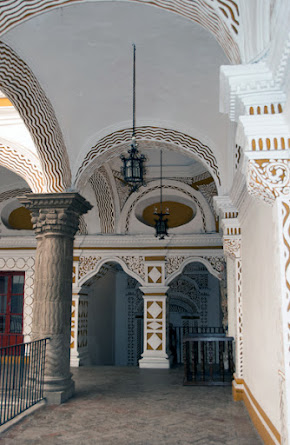Perhaps the most interesting residential building from the latter part of the seventeenth century in Puebla is the outstanding Casa de las Bovedas (The House of the Vaults) by the noted Sevillian architect Diego de la Sierra (1656-1711), which dates from 1685. De la Sierra was a prolific architect, with several commissions in the city.
The residence follows the typical plan of an upper-class poblano residence, namely, a two- or three-storied building, with the central courtyard connected to the street, the lower story dedicated to a series of rooms with a street access for rent, and interior rooms dedicated to storage or also for rent, and a back-service courtyard. The upper story acted as the piano nobile (noble floor), containing the family rooms, the kitchen, and the private family chambers.
The mansion, commissioned by Diego Peláez, a high-ranking church official in 1684, is one of the most ingenious works of architecture in the city. In it, Sierra's design essentially inaugurated the Baroque era for civic architecture here by introducing new construction and ornamental solutions.
The house derives its name from the vaulting employed throughout the residence as roofing instead of the cheaper alternative of flat slabs supported with timber beams. The profusion of this style of roofing lends magnificence to the house’s interior spaces.
However, the house’s most original trait remains its decorative character. Indeed, around the main courtyard, architectural elements, such as columns, arches, lintels, jambs, and vaults, were carved with a variety of sinuous zigzagging lines - a Mexican Baroque style known as barroco de estrías moviles or moving fluted Baroque.
However, the house’s most original trait remains its decorative character. Indeed, around the main courtyard, architectural elements, such as columns, arches, lintels, jambs, and vaults, were carved with a variety of sinuous zigzagging lines - a Mexican Baroque style known as barroco de estrías moviles or moving fluted Baroque.
On window jambs, lintels, arch intrados, and pilasters, the lines were carved in stucco, while on columns and corner piers, cut from basalt.
The lack of symmetry in the facade, with the main portal pushed to its left, east end, suggests instability and movement, as entries traditionally opened in the middle of the facade. This disruptive pattern continues with the facade’s openings and on the upper-level their varied scale, the use of rustication, tritostyle Corinthian pilasters, and triangular pediments boxed in semicircular ones . Between the openings the rest of the facade is covered in a classic poblano manner with red bricks (ladrillos) in a herringbone pattern, interspersed with blue and white glazed azulejo tiles.
The lack of symmetry in the facade, with the main portal pushed to its left, east end, suggests instability and movement, as entries traditionally opened in the middle of the facade. This disruptive pattern continues with the facade’s openings and on the upper-level their varied scale, the use of rustication, tritostyle Corinthian pilasters, and triangular pediments boxed in semicircular ones . Between the openings the rest of the facade is covered in a classic poblano manner with red bricks (ladrillos) in a herringbone pattern, interspersed with blue and white glazed azulejo tiles.
Above the doorway to the house is a medallion with a relief that is related to the later use of the house. After 1813 it was the headquarters of the Charity Board for the Good Education of the Youth, first as the tenant and finally the owner of the house.
The plaster relief represents the Child Jesus as the Good Shepherd , and was chosen as a shield by the Charity Board. Jesus is represented as a shepherd of sheep, shepherd of souls. In this case, Jesus Niño is standing in the middle of the field, next to a leafy tree, dressed in a tunic tied at the waist with a ribbon, He wears a hat and with his hand right feeds one of his sheep, while several of them surround him.
The choice of this image as the shield of the institution is related to the position of the members of the Board of Charity who saw themselves as the shepherds who guard their flock, enlightened poblanos who guide and lead the orphaned children of Puebla.
The plaster relief represents the Child Jesus as the Good Shepherd , and was chosen as a shield by the Charity Board. Jesus is represented as a shepherd of sheep, shepherd of souls. In this case, Jesus Niño is standing in the middle of the field, next to a leafy tree, dressed in a tunic tied at the waist with a ribbon, He wears a hat and with his hand right feeds one of his sheep, while several of them surround him.
The choice of this image as the shield of the institution is related to the position of the members of the Board of Charity who saw themselves as the shepherds who guard their flock, enlightened poblanos who guide and lead the orphaned children of Puebla.
Another work of note is the sumptuous polychrome relief of the Virgin, portrayed with some of her customary symbols, situated on the upper level of the patio.
text © 2022 Richard D. Perry
images courtesy of Niccolo Brooker and from online sources.








No comments:
Post a Comment